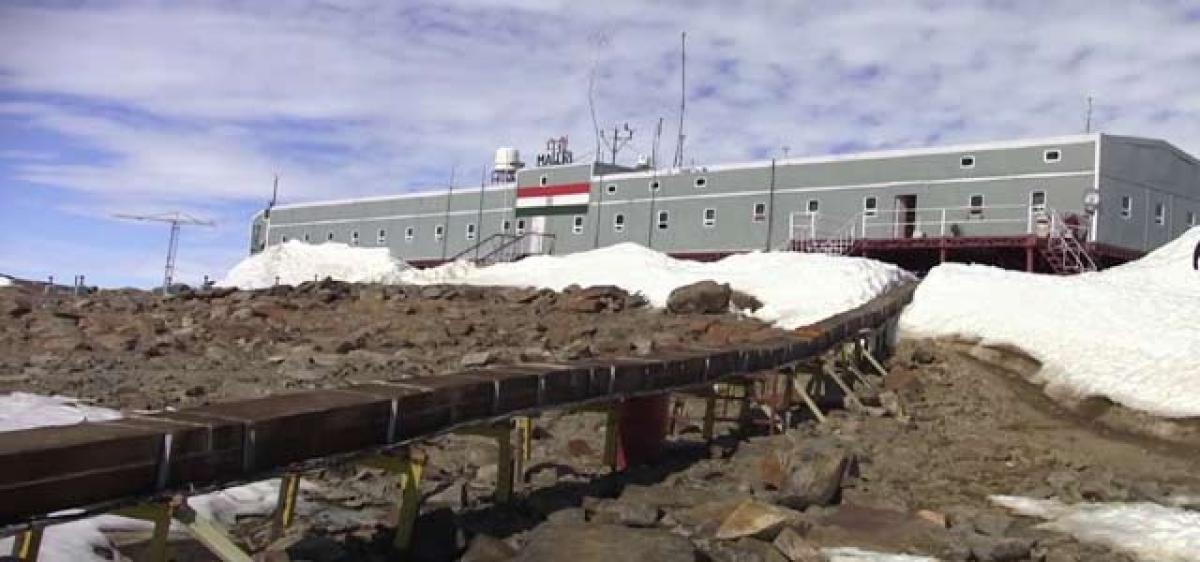India’s tryst with Antarctica

Antarctica, the fifth largest, uninhabited, southern most planet of Earth holding 75 per cent of freshwater reserves continues to enchant scientific community.
Antarctica, the fifth largest, uninhabited, southern most planet of Earth holding 75 per cent of freshwater reserves continues to enchant scientific community.
The inhospitable conditions, extreme weather conditions (extreme cold, dryness and windiness) haven’t deterred the spirits of the nations to explore the humongous diversity of fauna and flora of the “white continent” with no sovereign status.
As early as 350 BC, Greeks predicted the existence of a landmass in the Southern most end of like the Arctic in the North. Antarctica is named after Greek word, “Antarktike”, meaning opposite of North.
Antarctica also known as the ‘White Continent’ has been enticing the scientific community for a long time. The frigid land now is home to many researches by several countries including India, who brave the horrendous weather for humanity. India joined the polar expedition and built its first base in Antarctica-Dakshina Gangotri in 1983 to carry out research activities and the scientific stint continues
Spanning the Antarctica circle and surrounded by the Southern Ocean, the continent formed 25 million years ago, is spread over an area of 14 million square km.
Almost 98 per cent of the continent is covered with ice which is 1.5km thick. If all the ice of Antarctica melts, sea levels will rise by about 60mts.
Like other continents, Antarctica has several geographical features like valleys, glaciers, mountains, volcanoes, rivers and lakes.
Recent reports of breakdown of Western Antarctica ice sheet raised several concerns. Being a cold desert with annual precipitation of 200mm, the continent is devoid of native inhabitants.
As of 2016, around 1000 to 5000 people from 135 countries are residing the region. None of them stay there permanently and members of scientific expeditions are periodically substituted to carry out research activities.
In 1773, Captain James Cook first discovered this extremely vast and rather unique continent while he was crossing the Antarctica circle.
Later expeditions from US, UK, Russia, Australia, and New Zealand circumnavigated the continent to explore the marine life, sub Antarctica islands and to map the region.
Unlike the Arctic region, which was explored for its mineral and oil wealth, less is known about Antarctica till the late 19th century.
In 1947, the US under the Operation Highjump sent largest ever expedition to the region. Gradually other countries started making forays into the region while Britain, France, Australia, Norway, New Zealand, Chile, and Argentina laid claims on Antarctica.
To stave off territorial claims and ban military and mining activities on the continent, Antarctic Treaty System was instituted in 1959 which entered force in 1961.
A total of 53 countries are party to the treaty as of 2016. It basically defined the continent as all the land and ice shelves south of 60˚S latitude as a scientific preserve and established freedom of scientific investigation.
The original 12 signatories included the countries which were on Antarctica during the International Geographical Year (IGY) 1957-58.
Apart from the aforementioned seven countries, the list includes Belgium, Japan, South Africa, Soviet Union and the US.
India became party to the treaty in 1983 with the establishment of its first research station Dakshina Gangotri.
The treaty didn’t recognise claims of nations, upheld the principle of common heritage of mankind and soon established a secretariat at Buenos Aries in 2004.
Antarctica is believed to be part of the southerly supercontinent Gondwana, the part containing all landmasses of Southern hemisphere.
Around 140 million years ago, Africa and South America split from Gondwana under severe strain with South Atlantic Ocean separating them.
From the Eastern-half Madagascar split from India, Australia and Antarctica together moved down South.
The inhospitable extreme weather conditions (cold, dryness and windiness) haven’t deterred the spirits of the nations to explore the “white continent”. As of 2016, around 1000 to 5000 people from 135 countries are residing the region. None of them stay there permanently and members of scientific expeditions are periodically substituted to carry out research activities
Until about 45 million years ago, both clung together, Antarctica began to freeze while Australia drifted northward.
Even now Australia continues to move North 1.2 inches every year. The landmass that is now the cold continent was once home to lush evergreen rain forests.
Due to the extreme cold temperatures of Antarctica all the organisms that existed were fossilised and preserved in perfect conditions.
Scientific community enthusiasm stems from the prospect of exploring fossilised remains, meteorites, etc.
Also, Antarctic skies are clear and free of radio interference and hence ideally suited for deep space research, satellite tracking has a great potential for covert surveillance.
Although a ban was imposed on militarisation of the continent the US, Chile, Argentina already have permanent military bases on the continent.
Countries like China, Iran, Turkey and Pakistan are using their bases “for dual-use, scientific research that is useful for military purposes.”
India after the victory of the 1971 Bangladesh war wanted to assert its global status and steadily harboured a secret ambition to reach the South Pole and setup a research station in Antarctica.
To realise this dream, a young researcher from the Physical Research Laboratory (PRL) Paramjit Singh Shera was deputed to join the 17th Soviet Antarctica expedition.
The joint agreements between ISRO and Hydro meteorological Centre of Russia, laid the foundations for India’s Antarctic Expeditions. In 1977, Indira Gandhi commissioned a study in 1977 for establishing a station at Antarctica.
In May 1981, department of Ocean Development was setup and Operation Gangotri was unveiled. India launched its first expedition in December 1981, which took off from Goa.
Hiring an ice-cutter MV Polar Circle from Norway, the expedition headed by Dr Syed Zahoor Qasim with 21 scientists, personnel, technicians, and Naval officers covered 21,366 km in 77 days and landed in Antarctica.
India’s first permanent base Dakshin Gangotri was setup during the third annual expedition 1983-84 at Princess Astrid Coast. It was a double-storey station had fully equipped laboratories to carry out studies in meteorology, seismology, geology, glaciology, microbiology, acoustics, and oceanography. Ever since establishment of the base, annual expeditions to Antarctica have become a regular feature
By 1983, India built its first base in Antarctica-Dakshina Gangotri. After establishing base in Antarctica, India ratified the Antarctic Treaty as a consulting member.
India’s successful Operation Gangotri caught the developed world by surprise. India has become member of Scientific Committee on Antarctic Research (SCAR) in 1986.
Before 1988, a close group of 12 signatories exerted full control over Antarctica. By ratifying treaty, India advocated for the Third World to be part of Antarctic Governance.
India also favoured abrogation of Convention on the Regulation of Antarctic Mineral Resource Activities and supported the Protocol on Environmental Protection to the Antarctic Treaty (AEP).
Consequently, all the countries that laid claims on Antarctica had to disband their mining plans. India ratified AEP in 1992 reaffirming its commitment to protecting the environment of Antarctica.
India’s first permanent base Dakshin Gangotri was setup during the third annual expedition 1983-84 at Princess Astrid Coast.
It was a double-storey station had fully equipped laboratories to carry out studies in meteorology, seismology, geology, glaciology, microbiology, acoustics, and oceanography.
Ever since establishment of the base, annual expeditions to Antarctica have become a regular feature. Unfortunately, India had to abandon the base in 1990 due to inundation.
India commissioned second permanent station Maitri in 1989 in the rocky Schirmacher Region, East of Antarctica. It is surrounded by one of the biggest fresh water lake-Lake Zublake or Priyadarshini.
After its establishment, in 1990-91 over 250 scientists and Naval personnel were stationed. By 1990, studies at Antarctica became more inter-disciplinary and several prestigious Indian Institutes participated in the annual expeditions.
Slowly the studies have become more environmental centric with issues like depletion of ozone layer, monitoring UV-B radiation, greenhouse effect dominating the agenda.
Ministry of Earth Sciences in 1998 established a nodal agency, The National Centre for Antarctic & Ocean Research (NCAOR) to implement India’s Antarctic Program, to monitor the maintenance of permanent station, establish National Antarctic Data Centre and Polar Museum.
By 2012, India has setup another permanent research station Bharati using 134 recycled shipping containers.
It is located 3500km east of Maitri with core areas of research on tectonics, oceanography, and geological structures.
The research focus of Bharati is to understand the phenomenon of continental breakup and to collect evidences of shared history of India and Antarctica.
(Both shared same coastlines and were part of supercontinent Gondwanaland).
Bharati built from prefabricated shipping containers, has an ambient working temperature inside so that researchers can work comfortably irrespective of the harsh temperatures outside.
The temperatures range from -89C in winter to -25 C in summer. Over 35 scientists and 10 Army personnel stay throughout the year in this station.
It can be disassembled without leaving a trace of brick and completely conforms to AEP.
To facilitate polar expeditions India has a set of Ocean Research Vehicles (ORV). The phenomenal contributions of ORV Sagar Kanya constructed in 1983 and ORV Sagar Nidhi commissioned in 2008 are highly reckoned.
NASA, National Science Foundation (NSF) and Smithsonian Institution through Antarctic Search for Meteorite Program (ANSMET) recently renewed search for meteorites in the cold continent, to know more about the primitive building blocks of the solar system.
ANSMET so far collected 23,000 specimens. Countries are keenly monitoring Antarctic ice sheets since they have larger implications on climate change.
Any rapid meltdown of ice will cause steep rise in sea levels. Antarctica has become a testing and acclimatisation ground for astronauts traveling to space.
The desert-like conditions of Antarctica closely resemble the conditions on the surface of Mars. NASA has tested robots to be launched on Mars in Antarctica.
More recently the Commission for Conservation of Antarctic Marine Resources announced a marine protected area of 598,000 sq miles in Ross Sea.
The region also called “Last Ocean” is largely untouched by humans and its nutrient rich water is home to around 16,000 species.
Scientific advancement has come a long way. Gone are those days when people were skeptical of exploring rather frigid, desolate and forbidding lands.
Thanks to rapid sophistication and innovation, scientific community is keen on embarking polar expedition to understand and unravel the mysteries of unexplored lands.

















